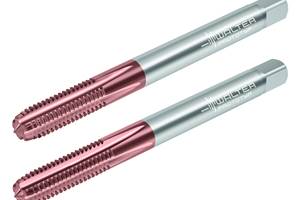Half-Inch Holes With Indexable Inserts
Small indexable inserts that can be used for hole drilling are a recent development.
Drills with cutting edges provided by indexable inserts have several advantages over conventional twist drill styles. Indexable insert drills never need to be reground. Edges are renewed quickly and simply by changing or indexing the inserts. These new edges are highly likely to be virtually identical to the ones they replace, whereas reground edges on a conventional twist drill are only as consistent as the skill of the person doing the regrinding will allow. Indexable inserts are also likely to have a lower cost per cutting edge, providing better economy in hole making operations. Insert-style drills for small holes, however, have been limited by the size of available inserts.
Small indexable inserts that can be used for hole drilling are a recent development. For example, the new MINI-U drills from Sandvik Coromant (Fair Lawn, New Jersey) take insert-style drills down to holes as small as one half inch in diameter and as deep as four times the diameter.
The MINI-U drills feature some other interesting design considerations that make them a compelling study in hole making theory. For example, each drill accommodates two inserts--but the inserts are quite different.
One insert is designed for cutting the center of the hole. The other insert is designed for cutting the periphery of the hole. Because cutting conditions are not the same at these areas of the hole, the chipbreaker geometry and the orientation of the corresponding inserts reflect different requirements for efficient metal removal. These differences may seem somewhat subtle but are quite critical. Indeed, Sandvik makes the two inserts different colors so that there is no confusion. Even the insert grades are different depending on the particular position in the drill.
Center inserts are grade GC1020 and peripheral inserts are grade GC1120. (Also available are peripheral inserts in grade GC4025 for drilling in steel.) The center cutting insert is offset and tipped at an angle to keep the drill on center. The chip geometry is designed to form chips that are easilyevacuated. The peripheral insert, on the other hand, is designed for efficient cutting at the higher surface speeds encountered there and to keep chips from jamming up the cutting edge.
Another unusual design consideration is in the flutes. The flutes, like the inserts, are not the same. The flute leading from the center insert helps the chips flow up and out quickly. The flute leading from the peripheral insert promotes smooth, unobtrusive chip evacuation to protect the surface finish of the hole. The asymmetrical flutes leave a substantially heavier web for a stronger, more rigid drill.
Because chip evacuation is critical to hole quality and hole making speed, these drills have two separate coolant lines to deliver copious amounts of coolant to the cutting edges. The coolant holes are located outside the webbing area where they do not affect the tool's rigidity. Having two coolant lines means that less fluid pressure is needed to deliver the same volume of coolant compared to tools with a single line that merely branches internally to two or more orifices near the cutting edge. With MINI-U indexable insert drills, the manufacturer indicates that 40 psi is adequate, although pressures as high as 300 psi are acceptable.
The MINI-U drills extend the existing Coromant U drill program. The assortment now features drills in diameters 1/2 inch through 1-3/16 inch with hole depths of three times diameter and four times diameter as standard. The company's Tailor Made program extends the program further to include five times diameter drills. Metric size drills range from 12.7 mm to 41.3 mm. Shank options include inch straight shank, cylindrical shank with flat, ABS, Coromant Capto, Varilock and Whistle Notch styles.
Related Content
Walter Offers New Solid-Carbide Taps for Blind-Hole Machining
Walter’s TC388 Supreme and TC389 Supreme feature patent-pending cutting geometries that fully shear off the root of the chip when reversing, thus minimizing torque peaks.
Read MoreNew Modular Tool Options for Small Spindle Milling
Tooling options have been limited for small spindle milling applications. Now modular, indexable systems are available that provide broad flexibility to get the right cutter for the job with less inventory and at lower cost.
Read MoreChoosing Your Carbide Grade: A Guide
Without an international standard for designating carbide grades or application ranges, users must rely on relative judgments and background knowledge for success.
Read MoreHow to Turn Machine Shop Downtime Into Process Expertise
To take advantage of a lull in business, JR Machine devised a week-long cutting tool event that elevated the shop’s capabilities with aerospace alloys.
Read MoreRead Next
The Cut Scene: The Finer Details of Large-Format Machining
Small details and features can have an outsized impact on large parts, such as Barbco’s collapsible utility drill head.
Read More3 Mistakes That Cause CNC Programs to Fail
Despite enhancements to manufacturing technology, there are still issues today that can cause programs to fail. These failures can cause lost time, scrapped parts, damaged machines and even injured operators.
Read More












.png;maxWidth=300;quality=90)












